The NVIDIA GeForce GTX Titan X Review
by Ryan Smith on March 17, 2015 3:00 PM ESTPower, Temperature, & Noise
As always, last but not least is our look at power, temperature, and noise. Next to price and performance of course, these are some of the most important aspects of a GPU, due in large part to the impact of noise. All things considered, a loud card is undesirable unless there’s a sufficiently good reason – or sufficiently good performance – to ignore the noise.
The GTX Titan X represents a very interesting intersection for NVIDIA, crossing Maxwell’s unparalleled power efficiency with GTX Titan’s flagship level performance goals and similarly high power allowance. The end result is that this gives us a chance to see how well Maxwell holds up when pushed to the limit; to see how well the architecture holds up in the form of a 601mm2 GPU with a 250W TDP.
| GeForce GTX Titan X Voltages | ||||
| GTX Titan X Boost Voltage | GTX 980 Boost Voltage | GTX Titan X Idle Voltage | ||
| 1.162v | 1.225v | 0.849v | ||
Starting off with voltages, based on our samples we find that NVIDIA has been rather conservative in their voltage allowance, presumably to keep power consumption down. With the highest stock boost bin hitting a voltage of just 1.162v, GTX Titan X operates notably lower on the voltage curve than the GTX 980. This goes hand-in-hand with GTX Titan X’s stock clockspeeds, which are around 100MHz lower than GTX 980.
| GeForce GTX Titan X Average Clockspeeds | |||
| Game | GTX Titan X | GTX 980 | |
| Max Boost Clock | 1215MHz | 1252MHz | |
| Battlefield 4 |
1088MHz
|
1227MHz
|
|
| Crysis 3 |
1113MHz
|
1177MHz
|
|
| Mordor |
1126MHz
|
1164MHz
|
|
| Civilization: BE |
1088MHz
|
1215MHz
|
|
| Dragon Age |
1189MHz
|
1215MHz
|
|
| Talos Principle |
1126MHz
|
1215MHz
|
|
| Far Cry 4 |
1101MHz
|
1164MHz
|
|
| Total War: Attila |
1088MHz
|
1177MHz
|
|
| GRID Autosport |
1151MHz
|
1190MHz
|
|
Speaking of clockspeeds, taking a look at our average clockspeeds for GTX Titan X and GTX 980 showcases just why the 50% larger GM200 GPU only leads to an average performance advantage of 35% for the GTX Titan X. While the max boost bins are both over 1.2GHz, the GTX Titan has to back off far more often to stay within its power and thermal limits. The final clockspeed difference between the two cards depends on the game in question, but we’re looking at a real-world clockspeed deficit of 50-100MHz for GTX Titan X.
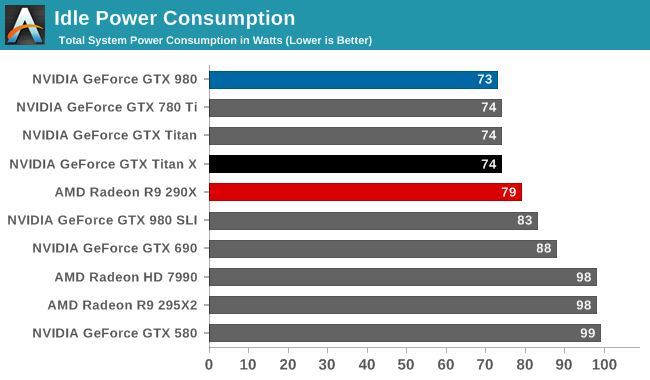
Starting off with idle power consumption, the GTX Titan X comes out strong as expected. Even at 8 billion transistors, NVIDIA is able to keep power consumption at idle very low, with all of our recent single-GPU NVIDIA cards coming in at 73-74W at the wall.
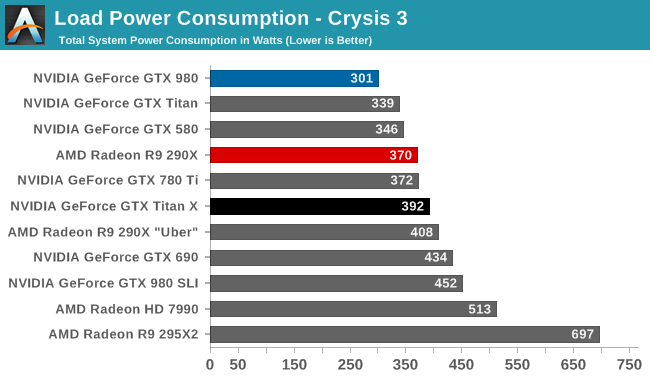
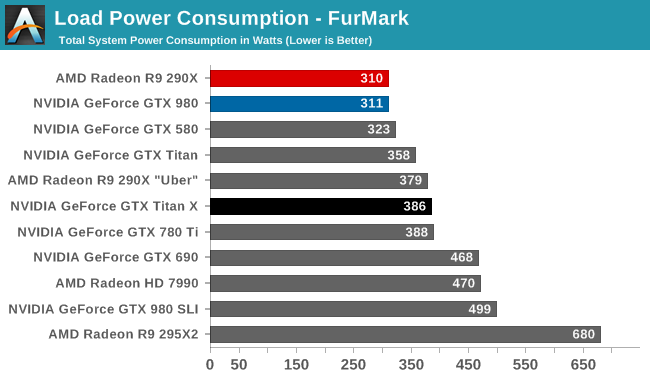
Meanwhile load power consumption for GTX Titan X is more or less exactly what we’d expect. With NVIDIA having nailed down their throttling mechanisms for Kepler and Maxwell, the GTX Titan X has a load power profile almost identical to the GTX 780 Ti, the closest equivalent GK110 card. Under Crysis 3 this manifests itself as a 20W increase in power consumption at the wall – generally attributable to the greater CPU load from GTX Titan X’s better GPU performance – while under FurMark the two cards are within 2W of each other.
Compared to the GTX 980 on the other hand, this is of course a sizable increase in power consumption. With a TDP difference on paper of 85W, the difference at the wall is an almost perfect match. GTX Titan X still offers Maxwell’s overall energy efficiency, delivering greatly superior performance for the power consumption, but this is a 250W card and it shows. Meanwhile the GTX Titan X’s power consumption also ends up being very close to the unrestricted R9 290X Uber, which in light of the Titan’s 44% 4K performance advantage further drives home the point about NVIDIA’s power efficiency lead at this time.
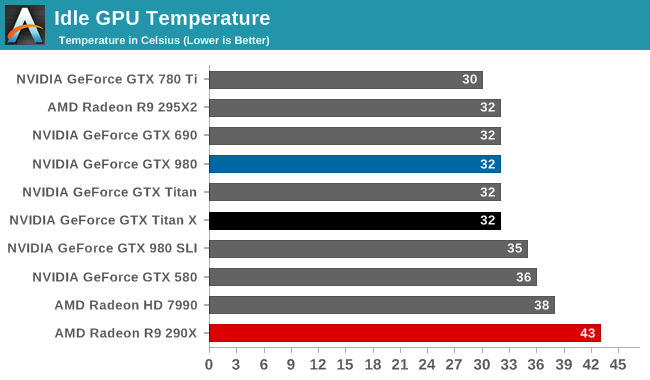
With the same Titan cooler and same idle power consumption, it should come as no surprise that the GTX Titan X offers the same idle temperatures as its GK110 predecessors: a relatively cool 32C.
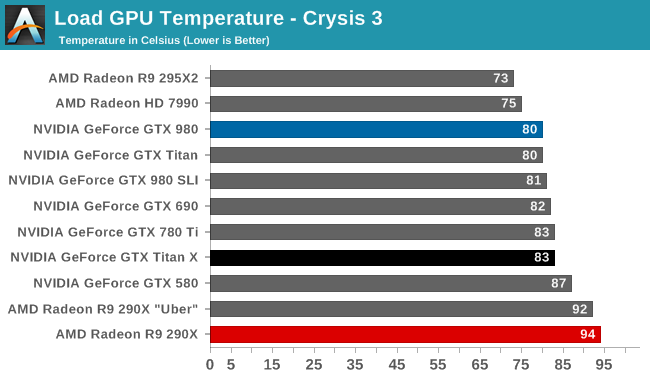

Moving on to load temperatures, the GTX Titan X has a stock temperature limit of 83C, just like the GTX 780 Ti. Consequently this is exactly where we see the card top out at under both FurMark and Crysis 3. 83C does lead to the card temperature throttling in most cases, though as we’ve seen in our look at average clockspeeds it’s generally not a big drop.

Last but not least we have our noise results. With the Titan cooler backing it, the GTX Titan X has no problem keeping quiet at idle. At 37.0db(A) it's technically the quietest card among our entire collection of high-end cards, and from a practical perspective is close to silent.
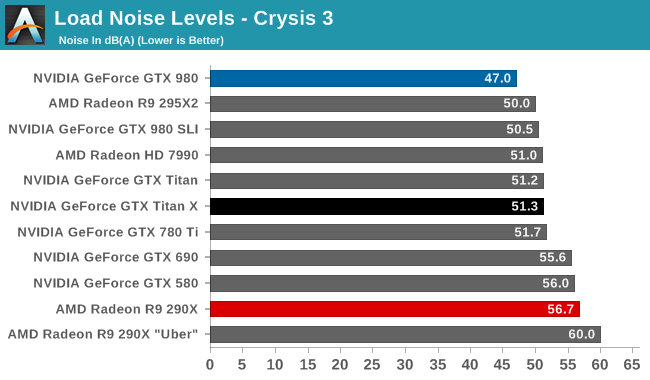
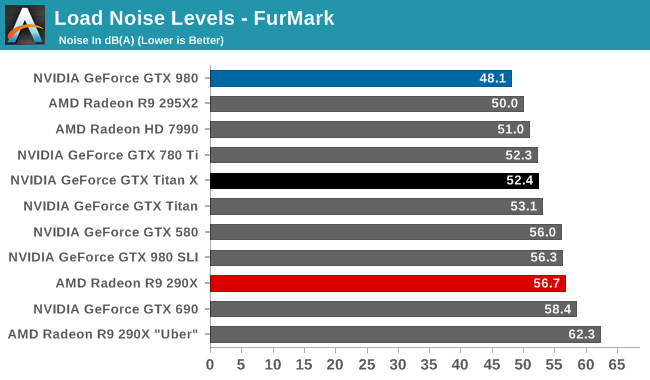
Much like GTX Titan X’s power profile, GTX Titan X’s noise profile almost perfectly mirrors the GTX 780 Ti. With the card hitting 51.3dB(A) under Crysis 3 and 52.4dB(A) under FurMark, it is respectively only 0.4dB and 0.1dB off from the GTX 780 Ti. From a practical perspective what this means is that the GTX Titan X isn’t quite the hushed card that was the GTX 980 – nor with a 250W TDP would we expect it to be – but for its chart-topping gaming performance it delivers some very impressive acoustics. The Titan cooler continues to serve NVIDIA well, allowing them to dissipate 250W in a blower without making a lot of noise in the process.
Overall then, from a power/temp/noise perspective the GTX Titan X is every bit as impressive as the original GTX Titan and its GTX 780 Ti sibling. Thanks to the Maxwell architecture and Titan cooler, NVIDIA has been able to deliver a 50% increase in gaming performance over the GTX 780 Ti without an increase in power consumption or noise, leading to NVIDIA once again delivering a flagship video card that can top the performance charts without unnecessarily sacrificing power consumption or noise.










276 Comments
View All Comments
nos024 - Wednesday, March 18, 2015 - link
Well lets see. Even when it launches, will it be readily available and not highly priced like the 290X. If the 290x was readily available when it was launched, I would've bought one.eanazag - Wednesday, March 18, 2015 - link
Based on leaked slides referencing Battlefield 4 at 4K resolution the 390X is 1.6x the 290X. In the context of this review results we could guess it comes up slightly short at 4K ultra and 10 fps faster than the Titan X at 4K medium. Far Cry 4 came in at 1.55 x the 290X.290X non-uber 4K ultra - BF4 - 35.5 fps x 1.6 = 56.8. >> Titan 58.3
290X non-uber 4K medium - BF4 - 65.9 fps x 1.6 = 105.44 >> Titan 94.8
290X non-uber 4K ultra - FC4 - 31.2 fps x 1.55 = 48.36 >> Titan 42.1
290X non-uber 4K medium - FC4 - 40.9 fps x 1.55 = 63.395 >> Titan 60.5
These numbers don't tell the whole story on how AMD arrived with the figures, but it paints the picture of a GPU that goes toe-to-toe with the Titan X. The slides also talk about a water cooler edition. I'm suspecting the wattage will be in the same ball park as the 290X and likely higher.
With the Titan X full breadth compute muscle, I am not sure what the 980 Ti will look like. I suspect Nvidia is holding that back based on whatever AMD releases, so they can unload a smack down trump card. Rumored $700 for the 390X WCE with 8GB HBM (high bandwidth memory - 4096 bit width) and in Q2 (April-June). Titan X and 390X at the same price given what I know at the moment I would go with the Titan X.
Stack your GPU $'s for July.
FlushedBubblyJock - Thursday, April 2, 2015 - link
If the R9 390X doesn't come out at $499 months and months from now, it won't be worth it.shing3232 - Tuesday, March 17, 2015 - link
1/32 FP32? so, this is a big gaming core.Railgun - Tuesday, March 17, 2015 - link
Exactly why it's not a $999 card.shing3232 - Tuesday, March 17, 2015 - link
but, it was priced at 999.Railgun - Tuesday, March 17, 2015 - link
What I mean is that it's not worth being a 999 card. Yes, it's priced at that, but it's value doesn't support it.Flunk - Tuesday, March 17, 2015 - link
Plenty of dolts bought the first Titan as a gaming card so I'm sure someone will buy this. At least there's a bigger performance difference between the Titan X and GTX 980 than there was between the Titan and GTX 780.Kevin G - Tuesday, March 17, 2015 - link
Except the GTX 780 came after the Titan launched. Rather it was the original Titan compared to the GTX 680 and here we see a similar gap between the Titan X and the GTX 980. It is also widely speculated that we'll see a cut down GM200 to fit between the GTX 980 and the Titan X so history looks like it will repeat itself.chizow - Tuesday, March 17, 2015 - link
@Railgun, I'd disagree and I was very vocal against the original Titan for a number of reasons. Mainly because Nvidia used the 7970 launch as an opportunity to jump their 2nd fastest chip as mainstream. 2ndly, because they held back their flagship chip nearly a full year (GTX 680 launched Mar 2012, Titan Feb 2013) while claiming the whole time there was no bigger chip, they tried to justify the higher price point because it was a "compute" card and lastly because it was a cut down chip and we knew it.Titan X isn't being sold with any of those pretenses and now that the new pricing/SKU structure has settled in (2nd fastest chip = new $500 flagship), there isn't any of that sticker shock anymore. Its the full chip, there's no complaints about them holding anything back, and 12GB of VRAM is a ridiculous amount of VRAM to stick on a card, and that costs money. If EVGA wants to release an $800 Classified 980 and people see value in it, then certainly this Titan X does as well.
At least for me, it is the more appealing option for me now than getting a 2nd 980 for SLI. Slightly lower performance, lower heat, no SLI/scaling issues, and no framebuffer VRAM concerns for the foreseeable future. I game at 2560x1440p on an ROG Swift btw, so that is right in this card's wheelhouse.